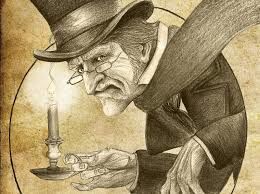
Charles Dickens is the most popular novelist in the English language and "A Christmas Carol" easily his most iconic story so it's not surprising that it would be a subject for early film. In fact there was a British adaptation as early as 1901, making it one of the earliest examples of a narrative story being told in film. Film as a medium had been around for about a decade but these early films were usually short (only a couple minutes) showing a slap-stick gag or some footage of an actual or staged scene (ie. lots of train rides) with no context. This earliest known Dickens' adaptation does however tell a proper story with a real plot and characters however truncated.
"SCROOGE, OR, MARLEY'S GHOST" (1901);
Directed by Walter Booth
Cast;
Daniel Smith ~ Scrooge
(rest of cast unknown)
The film is listed as being about five or six minutes long, which was standard for films of the era, however the only surviving print is only three and a half that and is clearly missing the last minute or so, however that doesn't ruin the story especially since we already know it off by heart anyway. This was common with the earliest films, directors chose story audiences were already familiar with (plenty of Dickens, Shakespere, Fairy Tales and Bible stories) knowing they could tell them with only a few scenes and a small cast in a couple minutes without dialogue. Taken as such this film was quite ambitious for it's time using some innovative special effects including double exposures to portray the ghost and visions of the past in a way that no doubt impressed audiences of the day. That said the sets are minimal stage backdrops which include bookcases and dish hutches which appear painted on. Also typical of the era the camera is completely stationary. The acting is typically stagebound but does not engage in the same amount of obvious mugging for the crowd of other films from the era. The story is obviously bare-bones but does run through the basics; Scrooge is a miser, he gets visited by Marley's ghost who shows him visions of his past, present and future and Scrooge then repents, the end. The story would obviously not have the impact for an audience who were not already intimately familiar with the story but the film-makers knew they would not have that problem. Note that this story dispenses with the three ghosts of the story and saves time by just having Marley's Ghost do the job. Apparently this was an approach taken in some stage versions of the time which this film borrowed from.
JC BUCKSTONE
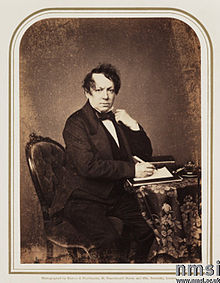
The script indeed is credited to JC Buckstone, an English actor who had played the role on stage Scrooge but here Scrooge is played by one Daniel Smith who was presumably also a lesser known stage actor who has no other known film credits. This does not mean he did not make other films in that era, only that there is no record of them, in fact we know nothing about him at all including when he died. He seems perfectly at ease so he must have had some experience but there is no record of it. A check of the Adelphi Theatre, a major London theatre of the Victorian/Edwardian eras does not list him even once, although he could have easily appeared elsewhere. At this date film was seen as a cheap novelty and beneath the dignity of a successful actor like Buckstone although he would later change his mind as we shall she. As for Smith he is adequate for the role, holding the screen without resorting to the histrionics and mugging of others of the era. The rest of the cast is unknown but director Walter Booth (1869 - 1938) was an important, if largely forgotten English film-maker of the era known for his early use of special effects. Like his contemporary he was also previously a stage magician (and artist) and it's possible he also appears in the film. Booth made several films including some early sci-fi films which still survive. He closed out his film career with another Christmas film with "Santa Claus" in 1912 (one of the earliest film Santas) and retired from film moving into advertising.
After this film there would be an American adaptation in 1908 which is now lost followed by another better known effort made by Edison Studios in 1910 using some of the same cast and crew from the version of "Frankenstein" which had come out earlier that year.
"A CHRISTMAS CAROL" (1910);
Directed by J Searle Dawley
Cast;
Marc McDermott ~ Ebenezer Scrooge
Charles Ogle ~ Bob Cratchit
William Betchel ~ Christmas Ghost (?)
Viola Dana ~ Cratchit's Daughter (13 yr old)
Shirley Mason ~ Cratchit's Daughter (10 year old)
The second American version of the tale was literally four times longer than the 1901 British version which gave them more time to tell a more complete, if still rushed, version. They also have better sets featuring proper looking rooms with actual furniture instead of painted backdrops. That said the shooting schedule for films of this era was very short (especially at Edison) and only a few sets are used with even the outdoor scenes clearly being shot indoors which is again typical of Edison. In fact most of the action takes place in Scrooge's bedroom as the ghosts show him various scenes as he reacts. Some of this drags a bit and it would have been better if the ghosts had taken Scrooge outside for this. The ghosts are shot using the same double exposure f/x as the 1901 film with a couple ghosts seeming to be looking off-center as the actors can not actually interact with the other players. Playing Scrooge is Marc McDermott who is an improvement over the 1901 version. He is tall with scowling, craggy features and stooped shoulders suggesting a tired, crotchety old coot, but still imposing enough to be intimidating. McDermott (1871- 1929) was an Australian actor with an established stage career when he was recruited by Edison Studios where he would appear in a version of "Les Miserables" (1909) and Jules Verne's "Micheal Strogoff" before "Christmas Carol". He would continue acting throughout the silent era appearing, usually as the heavy, in some of the first film serials along with crime dramas "Eugene Aram" (1915), "While New York Sleeps" (1920), the Lon Chaney classic "He Who Gets Slapped" (1924) and the WW1 drama "Under The Black Eagle" (1928). Evidently a hard drinker he died of liver cirrhosis aged only 57 just before the sound era.
Better known to modern audiences is Charles Ogle (1865 - 1940) who gained immortality as the first screen Frankenstein's Monster earlier that year. Given he had played the hulking monster one might have thought he would play Scrooge but instead he plays the mousey Bob Cratchit with much servile eye-rolling. Given how Ogle lurked over everybody in the earlier film (even assuming he was wearing elevated shoes he is listed as being 6.2) McDermott must have been quite tall as he towers over even Ogle. Like McDermott he was also a stage actor who had appeared on Broadway with "Frankenstein" being his fifth film. He had also appeared with McDermott in "Micheal Strogoff", and the two would later appear in the same crime serials. Among his very long list of credits was as Long John Silver in "Treasure Island" (opposite Lon Chaney) and an appearance in Cecil B DeMille's "The Ten Commandments". He retired from the screen aged only 50 before sound came in 1926 and died aged 75.
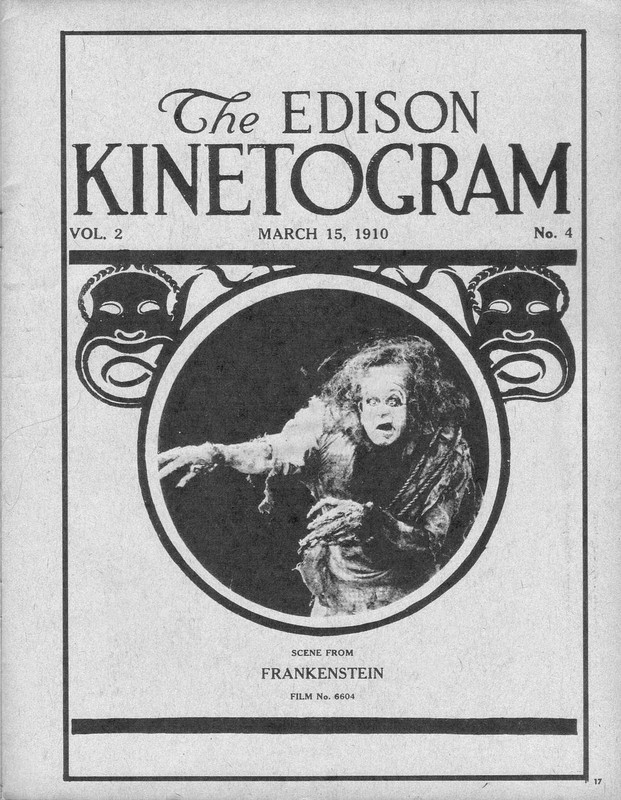
Also listed in the credits is William Betchel (1867-1930) who presumably plays one of the Christmas Ghosts or one of the Charity Fundraisers who visits Scrooge as it appears one of the actors may be playing a dual role. Betchel was a German actor who by 1910 was both too old and too heavyset to be the actor playing Scrooge's Nephew. This was Betchel's first film although it's probably safe to assume that like McDermott and Ogle he had a previous stage career. He would end up having an even longer, if lower profile career than either which included "The Jazz Age" (1929) with Douglas Fairbanks acting up to his death in 1930 aged 63.
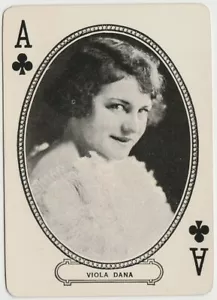
Also notable are two girls playing Cratchit's Daughters, Viola Dana (1897-1987) and Shirley Mason (1900-1979) were actually sisters (real name; Flugrath) with this being their film debut although they had already appeared on stage along with a third sister, Edna Flugarth. They would go on to successful careers in the silent era with Mason appearing in "Treasure Island" (with Charles Ogle and Lon Chaney) and "Flame Of Youth" (1920, written by Barbara LaMarr) while Dana would appear in director Frank Capra's first film "That Certain Thing" (1928). The sisters would appear as sisters a few times although oddly one of Viola's last films was "Two Sisters'' (1929) with Boris Karloff, an early sound film where Viola plays the dual role of two sisters. This film is now lost. As an added irony both Viola and Shirley would marry film directors who would die young with Viola's husband , director John Collins, dying in the 1918 Pandemic while Shirley's husband actor/director Bernard Dunning (who married when she was 16 and he was 24) dying of typhoid in 1923. With the coming of sound the sisters (who remarried) retired from film and lived long and apparently happy lives.
=================================================================
"SCROOGE" (1913)
Directed by Leedham Bantock
Cast;
Seymour Hicks ~ Ebanezer Scrooge
William Lugg ~ Jacob Marley
JC Buckstone ~ Bob Cratchit (?)
Leedham Bantock ~ Charity Man
Adela Measor ~ Mrs Cratchit
Ellaline Terriss ~ Helen
Dorothy Buckstone ~ Fann (?)
Leonard Calvert ~ Fred Scrooge (?)
Osborne Adair ~ Charles Dickens (?)
Betty Hicks ~ Cratchit's Daughter (?)
The film opens with a scene of Charles Dickens writing the novella which dissolves into an image of Hicks as Scrooge. Finally here we have a Scrooge with appropriate menace. Hair askew, eyebrows like caterpillars, ragged clothes and flushed complexion which the intertitles helpfully blame on his cold, cold heart. Although Hicks was in his forties he looks much older and like McDermott he walks with a crooked stagger. He looks more like a homeless wino than a millionaire which may be taking being a miser a bit far. Instantly the audience knows he is a miserable old bastard who in the opening smacks around one of a group of urchins taunting him (to be fair they do seem pretty annoying). Since this version is literally twice as long as the Edison version from only three years previous it can spend more time on it's story. Whether it spends that time well is another matter. Half the film is spent on setting up the story, introducing Scrooge and establishing that he is a miserly bastard. There is nothing wrong with this, Hicks does a fine job and he is the first proper Scrooge on film helped by the fact that he had already established the role on stage for years. However this means that there is not enough time to tell the story of Trump's visitations and redemption, in fact the film compresses four ghosts into one by making Jacob Marley be the only ghost and dispensing with the Ghosts of Christmas Past, Present and Future. This is a glaring omission that even the much shorter 1910 Edison version did not do. Like the Edison film this version does not leave Scrooge's bedroom for the visitations with Marley simply showing Scrooge visions that he passively observes and reacts to. This is odd as the opening scenes do in fact change sets five times and made good use of outdoor sets which, unlike the Edison films, were actually shot outdoors. The sets, especially the outdoor sets, are actually a strong point here, they looked lived-in and appropriately cold, grimy and..well..Dickensian. As do the rather threadbare costumes. This London does indeed seem harsh and miserable. The cast here is clearly superior to the previous films, Hicks was a well respected actor with years of experience in the role and most of the cast here were also well known London stage actors and while they had little film experience they had had time to observe the medium and look comfortable in it. Besides Hicks, Marley's Ghost stands out as being particularly cadaverous. So it's clearly a better film than the 1910 Edison version, however it could have easily been made better. Forty minutes was considered a standard length for a feature film but longer films were not unheard of and another twenty minute reel could have easily been added, especially for a film with a recognized story and stars that could be expected to find an audience and be exported to North America and Australia as this one would be. This would have allowed the film to spend the kind of attention on the rest of the film that it spent on the set-up. Additional time could have been had by simply dispensing with the opening framing device of showing Dickens at work which looks fine but adds nothing to the story and was already pretty creaky as a narrative device even in 1913.
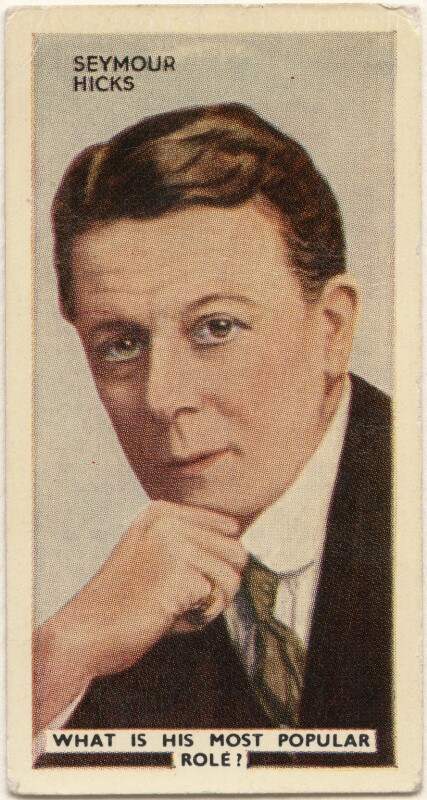
Seymour Hicks (1871 - 1949) had been a major star of the London stage for years including working with Sir Henry Irving and Charles Frohman, when he began playing the role of Scrooge with a script he wrote, starting in 1901 playing the role thousands of times with great success allowing him to set up his own company and build his own theatres, the Aldwych and Hicks Theatres. His company included family members including his wife, Ellaline Terriss and brother-in-law Tom whose father William Terriss was a well known actor in his own right who Hicks had worked with until he was murdered in 1901. Hicks was the best known Scrooge of the Edwardian stage so his moving the role to film was a natural. Like most stage actors of the 1900's Hicks showed little interest in the crude film vignettes of the early era, however by 1913 film media had advanced in its ability to tell a proper story lasting longer than a single reel. Seymour Hicks would continue to play Scrooge and other characters on stage along with making some movies into the sound era which would lead to the first sound remake in 1932 which we shall visit later. He was knighted in 1935. As for the rest of the cast; unlike the previous films we do have a cast list, albeit without listing who played what roles. However since much of the cast were prominent players at least some of whom played in the stage version so we can make some educated guesses. Hick's wife Ellaline Terriss appears to play Scrooge's girlfriend from Christmas Past. Besides resembling photos of Terriss, it's effectively the only female role with any decent lines so it's likely Hicks would give the role to Ellaline. William Lugg was an actor and singer who had appeared with Hicks and Terriss and given that he was a singer known for his booming bass voice it seems likely he would have played Marley's Ghost on stage and here although his deathly white makeup makes it hard to tell. Oddly JC Buckstone was an actor who had also played Scrooge in yet another stage version years earlier and he appears to be Bob Cratchit, the only other substantial role here and it's hard to see him taking a lesser role. The existing photo of Buckstone seems to confirm this. The wonderfully named Leedham Bantock, who actually sounds like a Dickens character, is listed here as both an actor and director of this film, and he had a Christmas film history of his own having played the first known film Santa Claus in a 1912 film directed by the same Walter Booth who directed the 1901 "Scrooge". The heavyset Bantock obviously plays the Charity Man who visits Scrooge seeking a donation. Leonard Calvert and the also wonderfully named Osborne Adiar round out the male cast and we know almost nothing about them. They each have only one more film credit (oddly in the same film) and there are no photos to be found. We do have their birth dates however so we know they were in their early fifties at the time of filming so they can only be playing either Scrooge's nephew Fred and Charles Dickens as the only other male roles are Tiny Tim and the lad who Scrooges sends out to buy the turkey on Christmas Day. They are completely unknown but it was not unusual for child actors to go unbilled in that era. As for the rest of the female cast; Adela Measor was the wife of JC Buckstone and she appears to be playing Bob Cratchit's wife. Dorothy Buckstone was apparently JC Buckstone's daughter (he did have an actress sister but she was named Lucy). She would appear to be playing Scrooge's sister Fann who appears in a Christmas Past vision as it's the only other female role aside from Cratchit's daughters, but they have no lines or scenes of their own. Dorothy had no other film credits but may have been a stage performer. As an additional note Hicks and Terriss had a daughter named Betty who would later become an actress as well so it's possible she played one of the Cratchit daughters. She was aged about ten at the time. The cast all do a solid job without too much of the histrionics and mugging of the era. This version of the story became the standard version for many years, probably due to the fame of it's cast, especially Hicks, and would be exported internationally (at least to North America, Australia, New Zealand etc) and shown through out the silent era even though it's static staging became distinctly old fashioned within just a few years and Hicks himself would reprise the role in the first sound version in 1932. But that's another story.
===============================
"A CHRISTMAS CAROL" (1914);
Directed by Harold Shaw Cast;
Charles Rock ~ Scrooge
George Bellamy ~ Bob Cratchit
Edna Flugarth ~ Belle
Franklyn Bellamy ~ Fred
Mary Brough ~ Mrs Cratchit
Edward O'Neill ~ Jacob Marley
Arthur Cullin ~ Ghost Of Christmas Past
Wyndham Guise ~ Ghost Of Christmas Present
H Ashton Tonge ~ Ghost Of Christmas Future
The 1913 Seymour Hicks film may have gotten the most attention but that didn't stop another British studio from firing off their own version a year later with a mostly obscure cast. This version is in many ways a superior film, there are four ghosts instead of one, the ghosts take Scrooge from his room instead of having the entire story take place in Scrooge's bedroom, the sets look lived in, the camera is a bit less static, scenes are shorter and thought has been given as to how to tell a story with editing scenes rather than simply relying in the intertitles to do the job.The double exposure special effects are much better done than previous films. In short while the Hicks film was made by theatre people who had not given much thought to film as a separate medium, this one was made by actual film makers, second string journeymen mind you, but professionals.
The one short-coming is Charles Rock as Scrooge. He does not have Hick's seedy, snarling presence and the film is not as gritty and grimy. Rock seems like merely a crotchety old coot and lacks Hick's hostility. On the other hand the Ghosts are more animated than previous with finally a proper Marley dragging his chains and lock boxes. The three spirits have their proper look with Christmas Past as a white bearded Druidic old man, Christmas Present as a younger version (albeit scrawnier than later versions would be with an oddly large fake nose) while Christmas Future is a stark figure in a dark robe, however unlike later versions he does have a face rather than a shadowy void and appears to speak to Scrooge, in fact he looks like Dante from "L'Inferno" (1910). George Bellamy as Bob Cratchit doesn't look as down-at-heel as Buckstone's version, indeed the entire cast is better dressed than previous versions. Franklyn Bellamy is a more dashing figure as Scrooge's nephew. His wife is played by perky and wide-eyed Edna Flugarth who was actually the elder sister of Viola Dana and Shirley Mason from the 1910 Edison version. She isn't given much to do but she does have a personality. Similarly Cratchit's wife is a cheery, roly-poly figure who looks rather more well fed than she should be but she has a jovial personality.
EDNA FLUGARTH

The cast as not as well known as the Hicks 1913 version but Charles Rock (1866-1919) had been making films since 1910 making him an early figure to move from the stage (where he had appeared in both London and New York and had also served as a playwright) into film. Among many other films his other credits included a version of "Trilby" (AKA "Svengali", 1914) with the famous British stage actor Sir Herbert Beerbolm-Tree. His career would not last long however as he died in 1919 aged only 53, perhaps in the Spanish Flu pandemic. George Bellamy (1966-1944) also had film experience going back to 1910 including working with Rock in a short 1912 biopic of "David Garrick" (they both played supporting roles), the two would also appear in a version of "The Prisoner Of Zenda" (1915) again as supporting players. Later he would also appear in one of Eille Norwood's Sherlock Holmes films in 1922 and would continue acting into the sound era retiring in 1933 and dying a decade later. Franklyn Bellamy (1886-1961) might be George's son, there does appear to be a resemblance, however he is listed as having been born in Malaysia and George was not. Don't know if George ever lived there so their names might be a coincidence. If so another coincidence is that he would also appear in a Sherlock Holmes film, albeit in a 1931 sound version with Raymond Massey. He would continue his career well into the sound era even appearing in one of the very first TV dramas, "Telecrime" in 1939. Sadly like all early BBC programming no copies were saved. After which he seems to have married and retired (from film at least) and moved to Cornwall where he would die decades later. Edna Flugarth (1892-1966) was the one cast member who had some public fame as one of the three acting sisters, although she would be lesser known than her sister Viola Dana. They were Americans but she spent some time in Britain where she would marry and where this film was made (she also had a role in "Trilby") before returning and after making a movie, "The Social Code", in 1923 with her sister Viola, she would retire long before the advent of sound. She would open a beauty salon in California and live a long life away from the public eye. Mary Brough (1863-1934), as Cratchit's wife was another stage veteran from a theatre family with a long career in supporting roles, mostly in comedies, working right up to her death. ===========================================================
"A Christmas Carol" (1923)
Directed by George Wynn
Cast;
Henry V Esmond ~ Scrooge
(Rest of cast unknown);
With a decade passing between the next adaptation we see a significant advancement in filmmaking techniques. Now we have proper close-ups, shorter scenes and quicker editing, still no tracking shots but it finally looks like a proper film. This version is supposedly missing several minutes but while it's short it's not cut off in the way damaged films often are, with the beginning or end obviously missing. Instead it looks like at some point somebody may have fixed this surviving print by re-editing to cover missing parts. For example the film goes from the Ghosts of Christmas Past to Present without introducing the latter while Christmas Past did get an intro and the Ghost of Christmas Present does hand Scrooge off to the Ghost Of Christmas Future, so that may be a missing scene. Then there is the ending, the film simply fades out after Scrooge tells Cratchit he will be turning over a new leaf and giving him a raise, then the film fades out. This means that we never actually see Cratchit's family nor do we even meet Tiny Tim. Even so this version does tell the basic story, albeit in the same rushed manner of the earlier versions. This film is also short by 1923 standards, when feature length films of over an hour long were standard, however comedy shorts were still commonly used as part of double bills and it's likely this film was meant to be used the same way during the festive season.
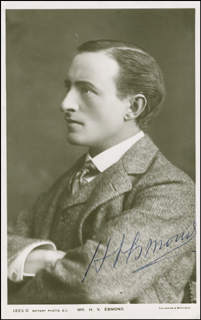
Scrooge is played here by Henry Esmond who does a good job, looking like previous Scrooge Charles Rock. He was in fact a prominent Broadway stage actor known for musical comedies who was expected to have an equally successful film career which was however, also like Charles Rock, cut short by his sudden death of pneumonia in 1922 aged only 52. The rest of the cast is unknown which is a shame because this Bob Cratchit is one of the better ones with the gangly actor bearing an odd resemblance to David Warner who would play the role sixty years later opposite George C Scott in the 1985 version. Marley's Ghost starts of with a promising closeup of his ghostly feet trudging across the floor dragging his chains and lock boxes. But once we see his face he looks more like a nagging clerk than a frightening spirit and once again the actor his a silly fake nose for some reason along with a stiffened hair pig-tail which would have been anachronistic in the 1840's. The other ghosts look fine and some good use is made of double exposures. This time Scrooge does leave his bedroom unlike most previous versions but this one is too short to do much with the story. The film is competently done and would have benefitted from having another reel to tell its story.
===================================================
"SCROOGE" (1923)
Directed by Edwin Greenwood
Russell Thorndike ~ Ebenezer Scrooge
Forbes Dawson ~ Fred
Nina Vanna ~ Fred's Wife
Jack Denton ~ Jacob Marley
Yet another British effort, this one is longer, at almost a half hour, but once again it doesn't make the best use of this time. The poor quality of this surviving print is obviously a problem but this version would be fairly mediocre anyway. Scrooge here is played by Russell Thorndyke who looks like some of the previous Scrooges, but although this film gives more time to establish the character he doesn't leave much of an impression. He is mostly just a cranky old coot except for one scene in which he charges outside to literally assault a caroling street urchin with a heavy bound ledger which is a tad extreme even for Scrooge. The rest of the cast is only partially listed leaving out, for some inexplicable reason, the actor playing Bob Cratchit, who is the most emaciated and servile clerk yet. The rest of the cast are serviceable enough but leave little impression except for the odd choice to have the Ghost Of Christmas Past be shown as a midget. Or is he supposed to be a child? This Marley doesn't get a dramatic entrance but at least he doesn't have the fake nose, although he does still have the stiffened pigtail. The other various spirits rush by quickly with The Ghost Of Christmas Present (a suitably giant Father Christmas) merely telling Scrooge that Cratchit and Nephew Fred will be having a merry christmas with their families and he won't before then exiting. The Ghost Of Christmas Future is the only one to actually take Scrooge outside, to his grave. Once again, as with the previous version we don't even see Cratchit's version and there is no Tiny Tim. In fact we spend more time with Nephew Fred & his wife than we do with Cratchit which seems off.
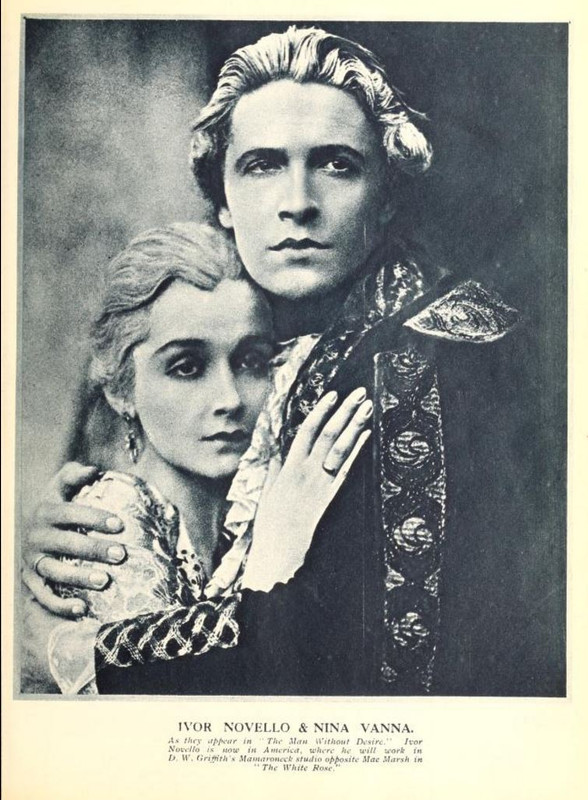
One change from previous versions is the heavy use of inter-titles and dialogue cards, in fact by the standards of silent film this one is downright chatty. Although the dialogue between Scrooge and Marley is somewhat out of sequence adding to the rushed feel of this film. The direction is pedestrian even compared to the earlier version (there are no closeups) and the sets minimal as well. Russell Thorndyke (1885-1972) was a British actor from a theatrical family along with his sister Dame Sybil, with a long stage career including playing Shakesperian roles as well as being a successful novelist. On film he had already played "MacBeth" opposite Sybil, and would later go on to act opposite Laurence Olivier in sound film versions of "Hamlet" and "Richard III". He spent much of his career on the stage however. Nina Vanna (1899-1953) as Fred's Wife is apparently the only other cast member of any note (she is billed up front and thus twice along with Thorndyke) and did in fact have several films to her credit including playing the lies of Lucreazia Borgia and Lady Jane Grey, although she is given little to do here. Vanna was actually a Russian stage actress named Nina Yasikova who fled the 1917 Revolution and ended up in Britain who was discovered by actor Ivor Novello who convinced her to try films and to change her name. She would make more than twenty films in Britain, France and Germany but retired with the coming of sound so perhaps her command of English may have been a little shaky. She died in Britain aged only 54.
Besides these surviving silent Scrooges there are lost versions including a 1908 version made by Essanay Studios starring Charles Ricketts and a big budget full length American version entitled "The Right To Be Happy" made by Universal Studios starring future film director Rupert Julian as Scrooge.


No comments:
Post a Comment